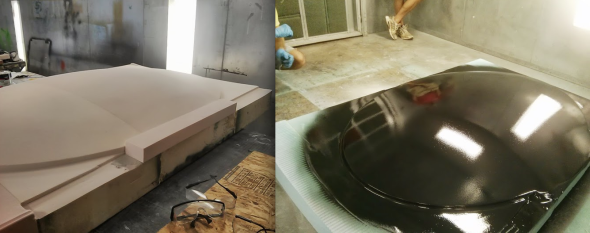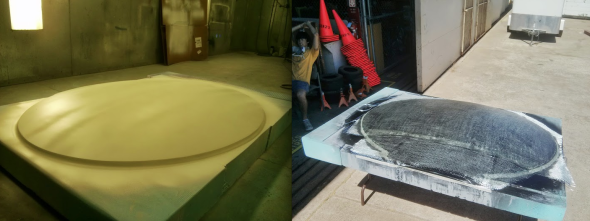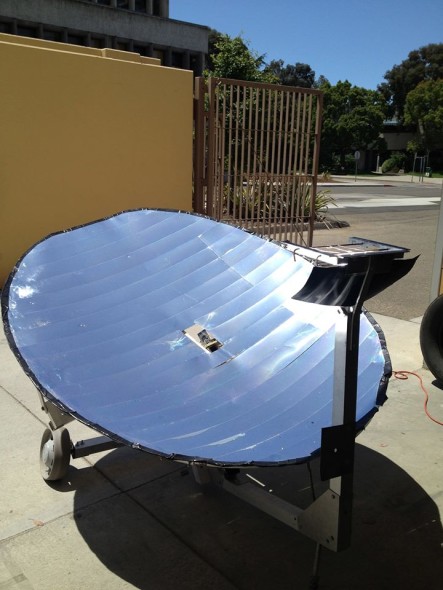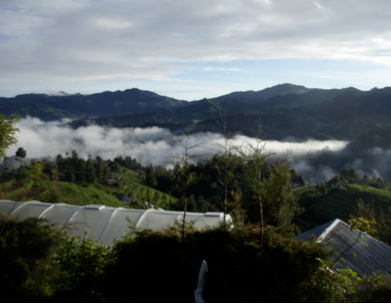A group of Cal Poly San Luis Obispo Engineering and Physics students recently took part in an amazing project designed to help residents of some of the world’s poorest locations cook food with solar energy.
Using the Scheffler Reflector concept (a large solar reflector that tracks the sun on a single polar axis, reflects the sunlight and concentrates it), Cal Poly students set out to make a reflector of their own that was less expensive and easier to manufacture. The present model with a reflector dish supported by a complicated aluminum matrix costs more than $4,000 to buy and ship from Germany.
The goal was to develop a working model that could be produced for less than $100. They planned to accomplish this by building a reflector dish that could be quickly and easily made from fiberglass cured over a mold.
To make the mold for the reflective dish, Precision Board HDU donated by Coastal Enterprises was CNC machined into a mold and coated with Duratec, followed by coats of polyester primer and sanding. The next step was a fiberglass hand-layup using fiberglass cloth and applying resin by hand.

After letting the fiberglass cure in sunlight, students pulled the fiberglass dish from the mold to find its shape flawless. The new dish is to be coated with aluminized mylar and fit into the simplified frame. By keeping design for manufacturability in mind, students were able to create a realistic solar cooking solution for fuel-challenged regions of the world – the first produced in North America.

According to Mechanical Engineering student and team member Simo Alberti, “The project was a huge success. Precision Board allowed us to quickly and easily create a highly-accurate mold for our reflector. When we totaled up what it cost to actually make our working prototype, it was just under $100. Not only that, but we used it to cook food all summer long. Kebabs, hot dogs, pasta, vegetables – as many types of food as we could.”

The solar reflector program is the brainchild of Dr. Peter Schwartz, Physics Professor at Cal Poly SLO, and evolved out of his larger Guateca program. Guateca is an ongoing project that involves annual summer trips with North American college students to the Guatemalan village of San Pablo, and serves as a cross-cultural educational platform for both Guatemalans and the US visitors.

According to Dr. Schwartz: “We plan to test the solar reflector in San Pablo this coming summer to see how it operates under real-world conditions. Additionally, our stateside goal is to produce 100 reflectors and see them operated locally so we can streamline our design based on feedback gleaned from the operators. Having the mold will greatly facilitate this task.”
Once the new inexpensive design is optimized, Dr. Schwartz plans to make the design public with the goal of encouraging eco-friendly, sustainable energy solutions worldwide. At the time of this publication, Cal Poly students had recently acquired an actual Scheffler Reflector for comparative research. They are also in communication with the people at Scheffler, who are very interested in this new design.
Additionally, through the SLO MakerSpace, http://www.sloidealab.com, one of the Cal Poly students plans to run a workshop where people can make their own concentrated solar cookers using the Precision board mold.
For more info about the fascinating Guateca project, please visit: http://www.guateca.com.

This is a time-lapse video compiled by Simo during the construction of the Precision Board layup tool:
http://www.youtube.com/watch?v=PMwaJJn5sZo&feature=share&list=UU0QHK7bLqOIXm8Xy0pGZOeA